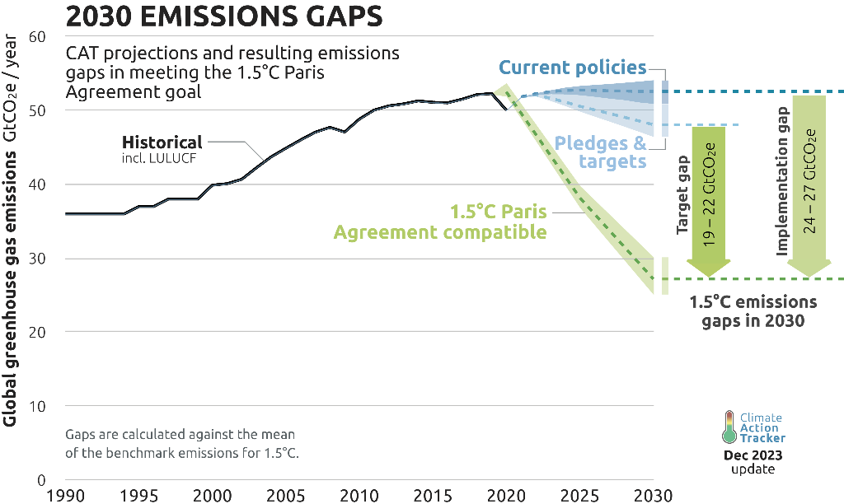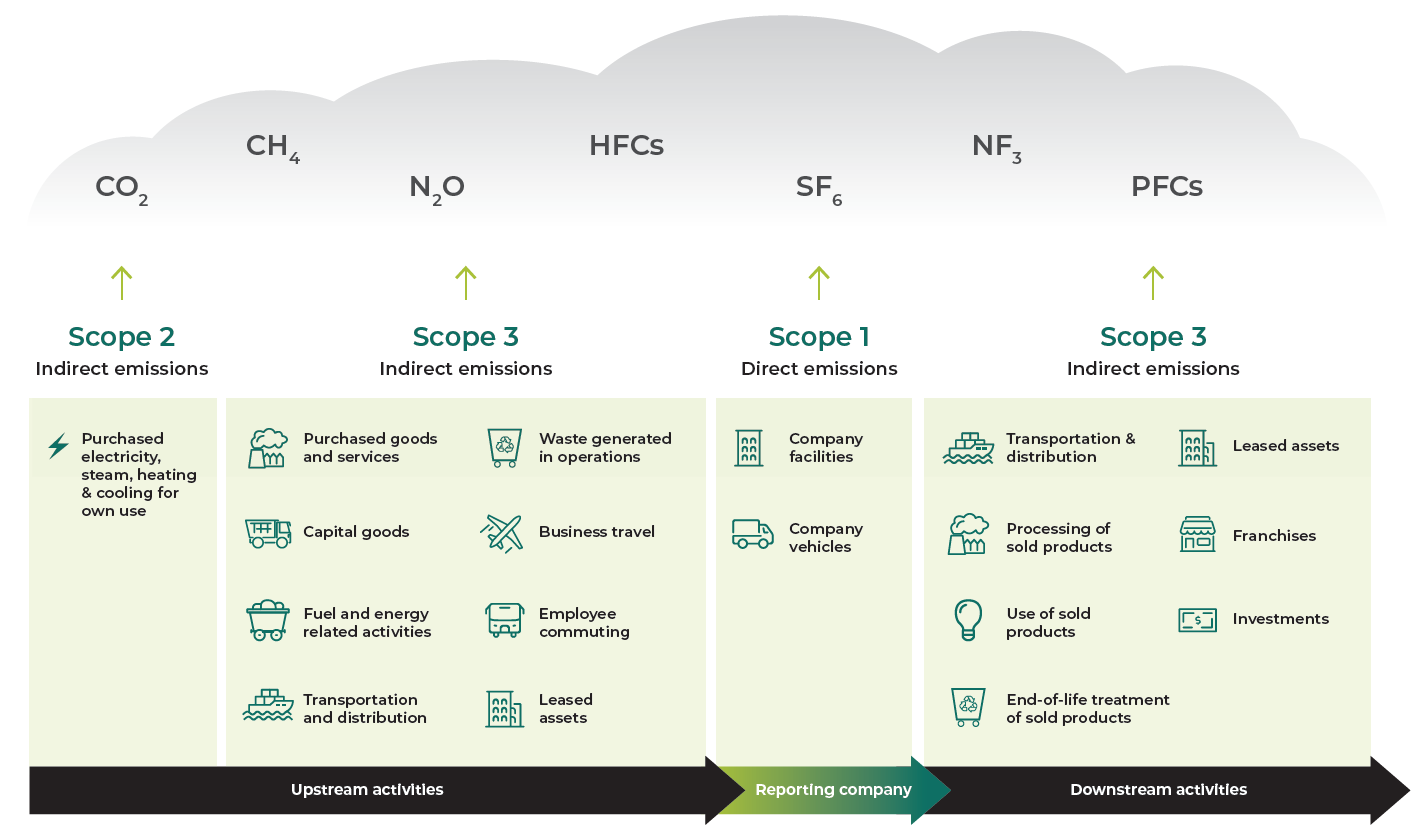- What are Scope 4 Emissions?
- Why are Scope 4 emissions important?
- How is Scope 4 different to Scope 1, 2 and 3?
- What is the difference between Scope 4 and Carbon Offsetting?
- How does Scope 4 benefit businesses?
- Scope 4 Reporting Frameworks
- Criteria for Scope 4 claims
- Challenges and arguments against Scope 4
- Conclusion
.jpg)
What are Scope 4 emissions?
The climate crisis and environmental concern is a topic that is saturating our global media. Whether you’re a member of the public, a business, or even the government, we are all reminded of the risks and crises we are facing.
For an issue of this magnitude, collective work needs to be done to try and minimise any further effect we are having on this planet. That’s why global business policies and procedures like the Green House Gas (GHG) Protocol’s Scope Emissions are growing in popularity as they set unified metrics that can measure a business's eco-success.
It is likely that you have already heard of the GHG Protocol’s Scope Emissions. Scope 1, 2, and 3 have given businesses a guideline on how to accurately mark how their business is doing in regards to CO2e. They have unified how all businesses across many countries measure their direct and indirect carbon emissions.
Yet, there is a new Scope emission that businesses should be aware of when looking at their carbon footprint; it's time to introduce Scope 4 emissions.
What are Scope 4 Emissions?
Scope 4 Emissions, also known as "Avoided Emissions", is a new concept in ESG and carbon reporting. It refers to the carbon emissions that are avoided through the use of a product, service or activity. It’s also sometimes referred to as “climate-positive accounting” and “net-positive accounting.”
The concept of Scope 4 is relatively new, and so it currently lacks an official definition. The GHG Protocol, the global framework for measuring scope emissions, does not yet include Scope 4. However, one of GHG Protocol’s founding companies, World Resources Institute (WRI), is leading the way on Avoided Emissions. The World Resources Institute (WRI) defines Avoided Emissions as:
“Emission reductions that occur outside of a product’s life cycle or value chain, but as a result of the use of that product.”
Being aware of scope 4 emissions and the concept of avoided emissions can be invaluable when developing a sustainability strategy. By understanding scope 4 emissions, businesses can better understand the potential savings from investing in sustainable projects and technologies and can make informed decisions about the suppliers they choose to work with.
Scope 4 emissions can also help inform Scope 3 calculations. Given that Scope 3 accounts for the majority of a business’s CO2 impact, and with Net Zero targets are looming closer, reporting on Scope 4 provides an opportunity for businesses to develop their reduction strategies further.
Why are Scope 4 emissions important?
Current action is insufficient as global temperatures continue to rise
According to the Climate Action Tracker Emissions Gap Report 2023, our planet is hurtling towards a concerning increase in global temperatures, anticipated to rise between 2.5 to 2.9°C above the levels before industrialisation took root. Despite strides forward since the inception of the Paris Agreement, the path to curbing global warming to a 1.5°C increase, without significant detrimental overshoot, demands a dramatic escalation in our efforts within this critical decade.
Source: Climate Action Tracker (2023). 2030 Emissions Gap: CAT projections and resulting emissions gap in meeting the 1.5°C Paris Agreement goal. December 2023. Available at: https://climateactiontracker.org/global/cat-emissions-gaps/. Copyright ©2023 by Climate Analytics and NewClimate Institute. All rights reserved.
The role of business
Significant disparities exist between the emissions reductions that are necessary and those that have been pledged by 2030. The business sector has the potential to make a meaningful difference by expanding the use of energy-efficient products, embracing low-carbon solutions, and pioneering innovative technologies.
This endeavor necessitates a robust corporate strategy centered around climate change, driven by an understanding of your company's GHG impact. As such, an increasing number of businesses are looking to ascertain whether their products contribute to an uptick or downtick in emissions, especially when compared to competing products that serve similar purposes in the market.
Gaining insights into these GHG emissions comparisons is crucial for spotlighting and advancing both existing and new products capable of bridging the emissions reduction divide.
Examples of avoided emissions

Cars
Companies with a fleet of Electric Vehicles will reduce their direct CO2e. But adopting further steps like fuel-saving tyres, which help the driver use less fuel, will result in a further reduction of GHG emissions. These tyres can be added to Scope 4 emissions.

Technology
Virtual technology has enabled companies to embrace flexibility and a work from home culture. In doing so, workers are avoided their usual commute and the CO2e associated with travel.

Cleaning
Using cleaning products that can be used with low temperature water means that less energy is needed to use the product. As there is no need to heat water, the manufacturer can market these low-temperature cleaning products to show how their products have avoided emissions.
How is Scope 4 different to Scope 1, 2 and 3?
Scopes 1, 2 and 3 are the categories that form a simple yet comprehensive framework that businesses use to measure and report on the direct and indirect GHG emissions associated to their activity. The framework is known as the GHG Protocol Corporate Standard.
- Scope 1: Direct emissions from sources that are owned or controlled by a company, such as emissions from fuel combustion, process emissions, and fugitive emissions.
- Scope 2: Indirect emissions from the consumption of purchased electricity, heat, or steam.
- Scope 3: All other indirect emissions in the value chain, such as emissions from the extraction and production of purchased materials, transportation of goods and services, and waste disposal.

In comparison, Scope 4 examines how the emissions that can be avoided due to the use of a company’s products or services.
Companies that use the Scope framework to measure and report their carbon emissions can better understand their environmental impact and identify opportunities to reduce their carbon footprint.
Unlike Scopes 1, 2 and 3, is not mandatory to report on avoided emissions, and there is currently no official protocol or standard to follow for this type of carbon reporting. This makes Scope 4 reporting incredibly difficult.
Even though there are ways to estimate avoided emissions, you can not 100% accurately calculate them as these emissions haven’t been created. No international standards on avoided emissions, and industries being left to develop their own methods of producing these numbers, can lead to inconsistencies and even greenwashing.
What is the difference between Scope 4 and Carbon Offsetting?
Although they sound similar, Scope 4 and Carbon Offsetting aren’t the same. Carbon offsetting is an opt-in scheme for businesses to invest in projects, such as tree planting, that aim to balance their CO2e impact. These emissions are already created, and businesses rely on offsetting organisations to quantify and rectify them through carbon credits.
Scope 4 is the reduction of carbon emission that occur outside of a product’s life cycle, as a result of the use of that product.
Here are a few more differences between Scope 4 and carbon offsetting:
- Scope 4: A reporting method calculating how a product/service swap can avoid emissions compared to its predecessor.
- Carbon Offsetting: A compensation method against emissions already made, utilizing projects like tree planting.
- Scope 4: Provides data for businesses to directly increase efforts in preventing CO2e from being made.
- Carbon Offsetting: Relies on indirect efforts of a third party, such as planting trees, to mitigate a business’s CO2e impact.
- Scope 4: Immediate effects after the swap, benefiting both the business and the planet.
- Carbon Offsetting: Project timelines, from initial investment to actual offsetting, are more extended.
How does Scope 4 benefit businesses?
Modern businesses have understood the environmental and business benefits of measuring their GHG emissions. And although it’s great for the planet, measuring your own CO2e impact is just one part of the solution.
With more companies looking to understand more about their Scope 3 emissions (most specifically, those that come from their value chain), addressing avoided emissions can give an insight into how to reduce emissions and encourage more sustainable strategies with their suppliers.
Businesses can be innovators in the climate discussion by pushing their products/services with lower emissions, causing a domino effect on their end-users CO2e. If standardised, Scope 4 can be an effective tool to help see the carbon reductions from their products/services. It can help show a business’s overall commitment and contribution to the climate.
Measuring Scope 4 emissions also presents direct business benefits, including:
- Regulatory compliance
- Tracking Progress
- Benchmarking in the industry
- Allocate for subsidies
- Grants to climate-positive companies
- Scope 3 reduction
Scope 4 Reporting Frameworks
As Scope 4 is the measurement of emissions that hasn’t been created, businesses should ensure that they are using the recommended and verified approaches to ensure a full and accurate estimate.
In helping address the wide metric of Avoided Emissions, there are two main methodologies businesses choose to follow, providing a framework and guidance on better reporting standards. These are the Attributional Approach and the Consequential Approach.
Attributional Approach
The attributional approach focuses on the direct removal of emissions associated with that product/service. It’s currently more popular than the Consequential approach as it allows businesses more leniency, understanding common issues like information constraints, time pressures, and difficulties in measuring uncontrolled wider variables.
Example of attributional Scope 4 reporting
If we were to use the attributional approach to investigate comparative impacts between cleaning products, we would quantify the carbon produced throughout the product's lifecycle (Cradle to Grave of the product) and compare that to the full life cycle of an alternative product.
Once the results of the carbon of each of those products are obtained, a quick calculation is made to find out what the avoided emissions are of that product.
Product A CO2e - Product B CO2e = Avoided Emissions

Consequential Approach
The more thorough approach of the two, the Consequential Approach widens its calculations by not only measuring the direct effects of the product/service (like the attributional approach), but also the secondary, possibly unintended impacts, such as consumer behaviour, market dynamics, and industry shifts.
Example of consequential scope 4 reporting
Although through the attributional approach, the avoided emissions may seem large, the consequential approach will try to quantify more variables because of more people using different cleaning products.
It will include factors like the potential in increase in dosing platforms being manufactured, or the increase of printing due to safety materials being re-printed. Although this approach is more data-centric, it does provide consumers with better insights and transparency of that product’s actual environmental impact.
The comprehensive approach allows for better insight into the overall environmental impact, whilst the attributional approach allows businesses that have data constraints to still benefit from Scope 4 reporting.
Choosing which methodology is best for the product/service is ultimately a business decision. However, to provide transparency and avoid greenwashing, businesses reporting on avoided emissions should make it clear which approach they have used.
Advantages and disadvantages of Scope 4 reporting
|
Attributional life-cycle accounting |
Consequential Approach |
|
|
Emissions attributed to a given product and an alternative that provides an equivalent function |
The total, system-wide reduction in emissions as the result of a change in output or behavior |
|
|
Advantages |
|
|
|
Disadvantages |
|
|
Criteria for Scope 4 claims
For businesses to measure and report on their product’s comparative impacts, the WRI suggests that businesses making Avoided Emissions Claims should tick off each of these criteria:

Complete Report on its full life-cycle (using the attributional approach) and/or the wider emissions changes from the use of that product (consequential approach).

Consistently using accounting approaches, data collection, and calculation methods.

Transparency, in your information will allow stakeholders to properly assess your claims and reliability.

Accuracy is key to creating the most useful scope 4 metrics.
Challenges and arguments against Scope 4
As Scope 4 is still in its infancy, it’s no surprise that reporting on avoided emissions is challenging.
Talking about these challenges should not act as a deterrent to its adoption, but bring a discussion as to how we can move forward and implement a methodology that benefits businesses, customers and the planet.
Because of the absence of a universally agreed framework, early adopters of Scope 4 reporting have started to develop their own approach. This poses a threat to the credibility of avoided emissions, as it can result in varying standards, inconsistencies, and greenwashing.
According to the WRI, based on a review of reporting practices, no company publicly reports negative impacts for its own products. In fact, 70% of the 1,793 companies that responded to the 2014 Carbon Disclosure Project (CDP) climate change survey indicated that the use of their products by a third party “avoided” emissions.
Whilst some companies are making bold claims about their products, others have chosen to simply refrain from approaching the subject of Scope 4 until there is guidance or regulation as they don’t want to be accused of making misleading statements.
Another common argument is that businesses already have too much to do with their current sustainability reporting. Companies should first calculate and report scope 1, 2, and 3 emissions and set science-based reduction targets for these emissions, and introducing avoided emission reporting may detract from these goals.
%20(1)%20(1)%20(1)%20(1).jpeg?width=1719&height=1747&name=AdobeStock_552236712%20(1)%20(1)%20(1)%20(1)%20(1).jpeg)
When will Scope 4 become mandatory?
Conclusion
Although Scope 1, 2 and 3 measure the GHG emissions directly from the business, Scope 4 is becoming the next evolution of C02e management.
Although it’s not claimed by the GHG Protocol, Avoided Emissions have been addressed by one of the founding organisations of GHG, meaning that businesses should be aware of this Scope. Using Scope 4 allows for businesses to reduce their C02e more easily and effectively. It can be a great asset to a business, by showcasing how their products/services will help avoid x amount of emissions.
However, the absence of international standards and procedures for Scope 4 may increase the risk of greenwashing. In the future, for businesses, their customers, and the planet to get the maximum true benefit from measuring Scope 4 emissions, regulations and policies are a must.
In the future, for businesses, their customers, and the planet to get the maximum true benefit from measuring Scope 4 emissions, regulations and policies are a must.



